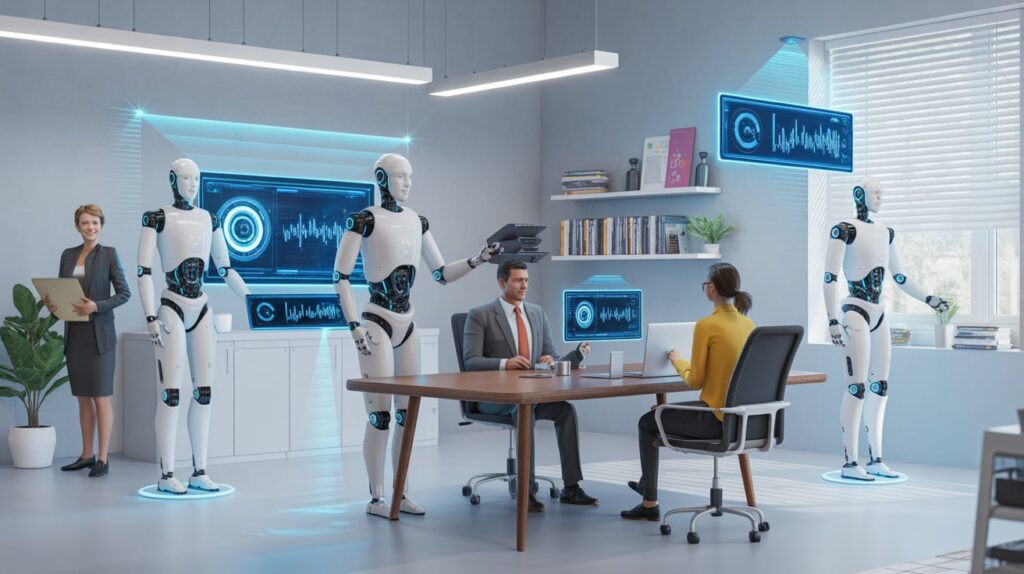Artificial intelligence used to be something we only saw in movies, but now it is all around us. From simple apps on phone to complex systems that manage global trade, machines are learning to think in smarter ways. These artificial intelligence trends are not just about technology, they are about how human life and work is changing every single day.
People often ask, is AI here to replace us or to help us. The truth is more complex. Some jobs are getting automated, but at same time new opportunities are created. Businesses save cost and improve performance, while individuals use intelligent apps to simplify life tasks. The transformation is big, and it is happening fast.
In this article we explore the most important trends in AI. We look at AI in business, the role of machine learning tools, the power of AI automation, and finally how AI innovation is shaping the future.
AI in Business – The New Digital Worker
Artificial intelligence is no longer a luxury for big corporations, it has become an everyday tool for small and medium companies too. Businesses are using AI for customer support, marketing, logistics and even for decision making.
Customer Experience Driven by AI
One of the clearest artificial intelligence trends in business is how customer experience is changing. Chatbots answer questions day and night, recommendation engines show people what they might like, and personalized emails are created without human typing each line. Customers don’t wait on hold for hours anymore, because machines take care of basic problems.
Decision Making with Data
Business leaders once relied on gut feeling or very limited reports. Now AI can process millions of data points in seconds. This shift is huge. With machine learning tools, companies can forecast demand, predict risks, and even plan marketing campaigns with more accuracy. This data driven decision making reduce waste and improve profits.
Reducing Cost and Errors
AI also bring efficiency. Tasks that take humans days can be done in minutes. For example, scanning invoices, checking contracts, analyzing medical reports. Machines don’t get tired and don’t make mistakes from stress. That’s why AI automation is one of the strongest forces saving companies millions every year.
Machine Learning Tools Shaping Daily Life
Beyond companies, AI also enters daily life of normal people. Whether we notice it or not, machine learning tools are already everywhere.
Personal Assistants Becoming Smarter
Think about Siri, Alexa, or Google Assistant. These are not just answering basic questions anymore, they are learning from our habits. They remind us of schedules, control our home devices, even make shopping easier. This trend of intelligent apps shows how AI is becoming like a digital helper for daily living.
Smarter Healthcare with AI
Doctors use machine learning tools to detect diseases earlier. For example, AI can scan X-rays and spot cancer signs faster than some human experts. Patients benefit from quicker treatment, and health systems save resources. Wearable devices track heart rates and sleeping patterns, giving real time health updates. This is one of the most positive AI innovations for human life.
Education with AI Tutors
Schools are also changing. Students now use apps that adapt lessons according to their learning speed. A slow learner get more practice, a fast learner get advanced challenges. Teachers use AI to grade papers faster and to see which students need extra help. The result is education that feels more personal than before.
AI Automation and the Future of Work
One area where people worry most is jobs. Many ask, will AI take away my work. The answer is complicated. AI automation is replacing some repetitive jobs, but also creating new ones that require human creativity and control.
Jobs That Machines Take Over
Jobs that involve repetitive tasks are at most risk. For example, data entry clerks, basic customer support, or routine factory workers. Machines do these tasks cheaper and faster. This is why some people fear losing their jobs. But the reality is that while some positions disappear, others are opening.
New Skills in Demand
The future worker need different skills. Instead of manual routine, humans focus on creativity, problem solving, emotional intelligence. People who learn to work with AI rather than against it have more chances to succeed. Training in coding, analytics, and design are now highly valued.
Work Life Balance with AI
There is also a positive side. AI can reduce human workload. If repetitive reports or scheduling is automated, workers have more time for important tasks. This can even improve work life balance. Imagine spending less hours on boring tasks and more on creative projects or personal time.
AI Innovation Driving the Next Big Leap
The biggest excitement around artificial intelligence is the future. AI innovation is moving fast, and new ideas are coming every year.
Intelligent Apps Everywhere
Phones, cars, houses – everywhere we look, intelligent apps are appearing. Self driving cars use sensors and AI to move safely. Smart fridges order groceries. Finance apps manage budgets automatically. This is daily proof of how artificial intelligence trends are not just theory but reality.
Ethical Questions Around AI
With all this growth come big questions. Should AI make medical decisions. Should machines decide who get a loan. Should robots replace teachers. These ethical debates are important. If society ignores them, AI could create unfair systems. Responsible AI in business means balancing efficiency with fairness.
AI and Human Collaboration
Finally, the future is not about machines replacing humans fully. It is about working together. A doctor with AI support makes better diagnosis. A marketer with AI insights creates better campaigns. A teacher with AI assistance gives better lessons. The power is in collaboration, not competition.
Final Thoughts
The journey of artificial intelligence is still young. But already artificial intelligence trends are changing how we work, how we learn, and how we live daily. Businesses use AI in business to grow faster and save cost. Individuals use machine learning tools and intelligent apps to make life easier. AI automation is reshaping jobs, while AI innovation keeps opening new doors for the future.
Yes, there are challenges. Job losses, privacy issues, ethical concerns. But history shows us that every big technology wave comes with fears. In the end, societies adapt, and new opportunities rise.
Smarter machines are not the enemy. They are tools. And like every tool, their value depend on how humans use them. If we focus on collaboration, fairness, and innovation, then AI will be remembered not as a threat but as one of the greatest helpers of human progress.



